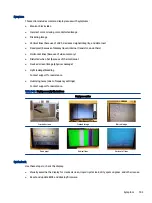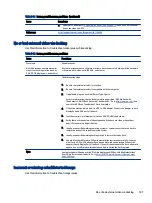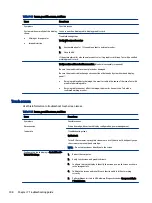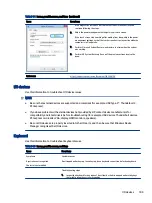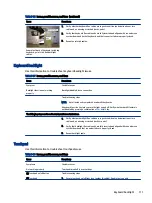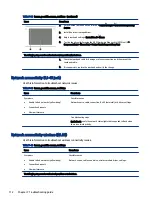
●
Update operating system (OS), graphics or video drivers (Intel, AMD, NVIDIA, and others).
For custom images, HP highly recommends upgrading or installing Windows in UEFI mode (or Legacy
disabled) to fully support hybrid graphics and avoid unexpected behaviors (for example, blue screen error,
graphics or video issues) in the BIOS Legacy setting.
●
Configure Windows settings (Power options, Screen brightness, Personalization, Screen resolution, and
so on).
●
Test with a verified working external display.
●
Boot to Windows in safe mode.
●
Test with a verified working operating system (for instance, shipping image).
HP PC Hardware Diagnostics (UEFI) for video test
Use this tool to quickly determine if the display issue is related to a real hardware issue.
To start HP PC Hardware Diagnostics (UEFI) (
6. HP Hardware Diagnostics and Tools on page 73
), when the
computer is at boot, press the
f2
key, select Component Tests, and then select Video.
There are three options:
●
Video Memory Check: to test video memory
●
Palette Check: to test the three video color components (red, green, blue)
●
Dead Pixel Check: to check dead pixels in eight different colors (Dead Pixel Check is available with the HP
PC Diagnostics 3-in-1 USB Key tool)
Review the video troubleshooting in the following Display section for specific issues and possible solutions.
For additional information about display problems, see documentation provided by the product manufacturer.
Display assembly diagram
The display assembly diagram shows basic video components: system board, graphics cards, display cables,
display connectors, operating system (OS), graphics driver, and LCD display panel. Any component or a
combination of these components can contribute to a video issue.
104
Chapter 7 Troubleshooting guide














